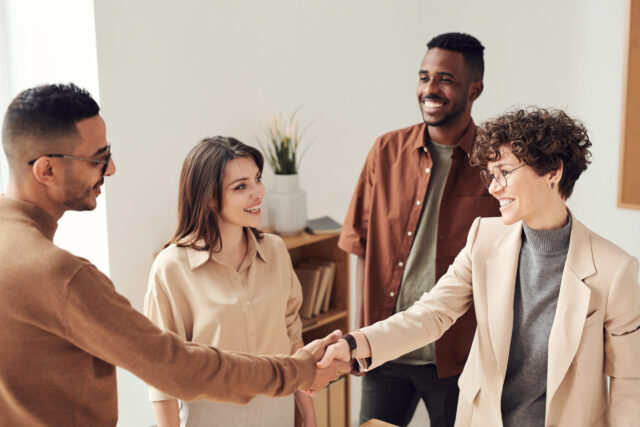I recently had a conversation with a colleague in the peacebuilding field, and we did not seem to agree on what a peacebuilder is or what approach is appropriate. This was a clear example of a gap in the unified definition of peacebuilding, and correcting this gap is important because various organizations and professionals who designate themselves as peacebuilders may come to the table with different types of agendas. In other words, if you involve a “peacebuilder” you may not always get what you thought you were getting.
According to the Secretary-General’s policy committee at the UN Peacebuilding Fund, Peacebuilding is defined as: “…a range of measures targeted to reduce the risk of lapsing or relapsing into conflict by strengthening national capacities at all levels for conflict management, and to lay the foundation for sustainable peace and development. Peacebuilding strategies must be coherent and tailored to the specific needs of the country concerned, based on national ownership, and should comprise a carefully prioritized, sequenced, and relatively narrow set of activities aimed at achieving the above objectives.”
The Alliance for Peacebuilding (AFP) defines the term as: “…an elastic term, encompassing a wide range of efforts by diverse actors in government and civil society at the community, national, and international levels to address the immediate impacts and root causes of conflict before, during, and after violent conflict occurs. Peacebuilding ultimately supports human security—where people have freedom from fear, freedom from want, and freedom from humiliation.”
For the most part, I agree with these conceptions, although the “elasticity” of such definitions seems a bit broad to me. Certainly, efforts to support human security and non-violence should be considered peacebuilding. But does that include any and all efforts which are claimed to have such intentions? This is where such a broad definition becomes elusive and opens the door for potentially contradictory efforts blanketed under the term “peacebuilding”. Below I present an argument for needed concensus on proper use and definition of the term. Please note: throughout the article, I employ the male pronoun (e.g. he, him his) only as a semantic tactic for conveneince and not to suggest that the field is in any way dominated by male practitioners–in fact, quite the contrary is probably true.
Without Unification There is Only Confusion
In every field offering professional consulting, it is important for the hiring parties as well as the consultants themselves to understand what the professional is and does. We have to know what we’re signing up for. We know what an attorney does. We know what an insurance agent does. We know what an accountant does. Of course, in every field, there are various types of specialities and subfields, as well as outliers and charlatans; but in general, we understand the role each is supposed to play prior to commissioning their input, the method they will likely employ, and the party they represent. Without a proper, unified definition or understanding of the professional’s role, however, there is no telling what credentials a consultant should have, what approach they should take, and perhaps most importantly, what goals they should maintain. If you contract a peacebuilder, for example, you may be getting a neutral mediator when you were hoping for an advocate, or you may be getting an activist when you were hoping for a neutral.
If we do not reconcile this semantic discrepancy, not only does it further stagnate the growth of the field, it dilutes the professional integrity of anyone calling himself a peacebuilder. For instance, if being an advocate can properly be defined as peacebuilding, then presenting oneself as a neutral when you’d like to convey your position as an advocate is counterproductive. And the same goes for one who intends to be a neutral, only to be presenting himself as an advocate by designating himself a peacebuilder.
Peacebuilding: Activism, Mediation, or Both?
A needs-based definition of peace is, in very concise terms: the satisfaction of basic human needs. When basic needs are satisfied, peace is a natural consequence. This includes both physical and psychological needs. Any hindrance of or threat to an individual or group’s basic human needs will naturally result in conflict.
 So, in my estimation, a proper definition of peacebuilding should include any non-violent method of helping parties satisfy their basic needs while designing and establishing systems that help prevent parties from threatening or impeding the others’ needs now or in the future. To me, that includes the needs of all parties with which I intend to interact during a peacebuilding mission. Within this framework, any initiative that seeks to fulfill all parties’ needs OR to satisfy one party’s needs without hindering another party’s needs can be thought of as peacebuilding.
So, in my estimation, a proper definition of peacebuilding should include any non-violent method of helping parties satisfy their basic needs while designing and establishing systems that help prevent parties from threatening or impeding the others’ needs now or in the future. To me, that includes the needs of all parties with which I intend to interact during a peacebuilding mission. Within this framework, any initiative that seeks to fulfill all parties’ needs OR to satisfy one party’s needs without hindering another party’s needs can be thought of as peacebuilding.
For instance, if only one party needs education or training of some sort, and you provide that education, that can be considered a peacebuilding effort because your efforts helped to satisfy the needs of and hence create more peace for that party. If the situation involves two conflicting parties, even if one party appears to be hindering or threatening the needs of the other, then shouldn’t a peacebuilding effort consider satisfying the needs of all parties involved? Or should peacebuilding seek only to equalize the parties, thereby occasionally advocating for the side that seems to be threatened or less empowered? By definition, however, the moment one transitions into satisfying one party’s needs regardless of or at the expense of the other party’s needs, haven’t you transitioned into advocacy or activism? There is, of course, a place for activism but is it right to conflate the term with peacebuilding under certain conditions? Theoretically, it seems to me that peacebuilding should bring peace to all involved, not simply to the side that the peacebuilder deems less empowered or more worthy of advocacy.
I have had this debate at least a few times now with individuals calling themselves peacebuilders. However, it is obvious quite immediately that they have an agenda that aligns with the side of the impoverished, the less powerful, and the begotten. Of course, disempowered parties in a power dynamic need advocates…but is that the job of a peacebuilder or, by definition, is it inherently beyond the peacebuilder’s scope?
 The advocacy position seems to suggest that in order to build peace, we must empower and fight against oppression and tyranny. And while I won’t deny activists undertaking this role might be correct in their designation as a peacebuilder (as I might be wrong in my own) and likely have peace as their ultimate aim, I do challenge their definition. In my estimation, once an individual takes sides, he or she is no longer a peacebuilder but rather an advocate or an activist. It takes all parties involved to come up with mutually agreeable, reasonable solutions to build lasting peace, and the job of a peacebuilder is to facilitate this. If a so-called peacebuilder, however, proclaims that one side is bad or wrong and is thus fighting for the rights of the disempowered side, how could he possibly facilitate? How could he possibly earn the trust and build rapport (with the “bad guys”) necessary to to facilitate a peacebuilding process?
The advocacy position seems to suggest that in order to build peace, we must empower and fight against oppression and tyranny. And while I won’t deny activists undertaking this role might be correct in their designation as a peacebuilder (as I might be wrong in my own) and likely have peace as their ultimate aim, I do challenge their definition. In my estimation, once an individual takes sides, he or she is no longer a peacebuilder but rather an advocate or an activist. It takes all parties involved to come up with mutually agreeable, reasonable solutions to build lasting peace, and the job of a peacebuilder is to facilitate this. If a so-called peacebuilder, however, proclaims that one side is bad or wrong and is thus fighting for the rights of the disempowered side, how could he possibly facilitate? How could he possibly earn the trust and build rapport (with the “bad guys”) necessary to to facilitate a peacebuilding process?
An activist or advocate is not a neutral or an impartial mediator. One cannot be the other by definition. So, the big question for the peacebuilding community is: What are we? Are peacebuilders neutrals or are we activists? My proposal is that we cannot be both. We are either looking out for the interests of all sides, considering all parties’ needs, and aiming for Win-Win solutions; or we are fighting for one side–whichever WE deem to have less power, have more important needs, or be facing more dire threats.
For those of us who think of ourselves as peacebuilders, we may get offended or upset at the notion of others who designate themselves in the same way only to have very conflicting aims for their work. An activist may be upset with me for not taking sides, while I may be put off by a non-neutral agent calling himself a peacebuilder.
If the field is to gain widespread acceptance and traction in common understanding, professionals in the peacebuilding community should or perhaps must agree on a unified definition and goal for the discipline. When such an alignment is established, either activists must stop calling themselves peacebuilders OR neutral mediators must stop calling themselves peacebuilders. That way, all those seeking peace via various methods will know what they are, and commissioning parties will know what they’re getting when they bring in a peacebuilder. Either we are friends to all and enemies of no one; or we are friends to the side who aligns with our pursuit of equality and enemies of any side who seems not to.
We have many activist and advocacy groups. They are incredibly important toward the peacebuilding effort; their significance is not in question. The question, on the contrary, is whether the term “peacebuilding” should be reserved for neutrals or whether it should comprise anyone using any method to achieve peace, even if it means fighting for the needs of one party and/or not considering the needs of the other.
So, what is a peacebuilder?
An Argument for a Definition as Neutral
 My proposal is that when a “peacebuilder” is called in to help parties through conflict, that neither side becomes immediately defensive at the thought. That both sides feel empowered by a peacebuilder as “a friend to all”, an advocate for all sides, a facilitator of dialogue toward getting everyone’s needs met. The minute one takes a side, you shut the other side out. The minute you have an opinion or agenda that involves disempowering one side to empower the other, you have seriously limited the opportunity for sustainable peace without force, coercion, or fear of punishment. You may negotiate a deal that one side is not happy with and the other is, but it can’t last long, at least not as a result of the intrinsic motivation of each party.
My proposal is that when a “peacebuilder” is called in to help parties through conflict, that neither side becomes immediately defensive at the thought. That both sides feel empowered by a peacebuilder as “a friend to all”, an advocate for all sides, a facilitator of dialogue toward getting everyone’s needs met. The minute one takes a side, you shut the other side out. The minute you have an opinion or agenda that involves disempowering one side to empower the other, you have seriously limited the opportunity for sustainable peace without force, coercion, or fear of punishment. You may negotiate a deal that one side is not happy with and the other is, but it can’t last long, at least not as a result of the intrinsic motivation of each party.
Our goal is either to make all sides somewhat satisfied in the outcome, or to constrain one side in the pursuit of the other’s satisfaction. Perhaps this sentiment and hope for peacebuilding to be considered advocacy for all parties (multipartiality) is not shared by the majority of the “peacebuilding” community. If so, I am open to using another term in describing myself and my practice. However, if a multipartial neutrality is the proper definition of peacebuilding, then it should be important for advocates, activists, and lobbyists of a particular side–those “fighting” for the rights, needs, interests, or positions of one party–to present themselves to the world as advocates, activists, or lobbyists and not as peacebuilders.
Those who disagree with this proposal, who fight for a party’s rights and identify as a peacebuilder, will likely take offense. They will scream, “How can you seek peace without fighting for the rights of the disempowered or seeking the downfall of tyrannical leadership?” The problem with that question is that it is mostly based on opinion and perspective, as many people can and will argue against it. For instance, perhaps you deem a leader as undeniably racist or authoritative, with many individuals supporting this notion and calling for your help to advocate for them in order to build peace. The problem is that, typically, many others (on the “other” side) will insist the leader is, in fact, not racist and is actually very democratic. In most conflicts, there are two completely contradictory perspectives of the same person or situation. Hence, we have a subjective, perceived truth — not an objective fact.
As a peacebuilder, the minute you take a position on an opinion or a perceived truth heavily debated — not an irrefutable fact agreed upon by most if not all interested parties — you will have a whole mess of people that are suddenly against you. You are essentially saying they are either wrong and ignorant, or tyrannical themselves by aligning with an apparent tyrannical position; and then you can no longer do the work of building peace. You have effectively shut the other side out. You have effectively made yourself a representative of one side, no longer neutral, no longer able to ethically mediate the situation, no longer able to seek peace but rather only able to seek victory. If victory is peace for both sides, wonderful. But if victory is peace for only one side regardless of what happens to the other side, you can no longer call yourself a peacebuilder…at least not in the definition I am suggesting here. I am open to being wrong about this; though I hope I am not.
 In some cases, it is quite clear and irrefutable that one party has done wrong. In cases of advocating against indisputable evidence of wrongdoing by an uncooperative party, we can attempt to force the wrongdoer to repent or change by means of exerting one’s own power and leverage over him, which typically only lasts for as long as the leverage or consequences are employed. In that case, perhaps peacebuilding is not the appropriate action but rather activism is, at least initially until the situation stabilizes. Sometimes diplomacy will not work and more extreme action must be taken. But eventually, if we are looking to truly build sustainable peace (i.e. get the wrongdoer to change behavior of his own volition rather than through coercion or threat), but you are perceived, whether accurately or inaccurately, as representing or advocating for only one side, you have a virtually impossible task as peacebuilder. As an advocate, you will likely not be viewed as a peacebuilder but rather as a representative or activist; in some cases, an advocate is warranted but we should be clear, not deceptive, on what exactly we are doing and what it should be called.
In some cases, it is quite clear and irrefutable that one party has done wrong. In cases of advocating against indisputable evidence of wrongdoing by an uncooperative party, we can attempt to force the wrongdoer to repent or change by means of exerting one’s own power and leverage over him, which typically only lasts for as long as the leverage or consequences are employed. In that case, perhaps peacebuilding is not the appropriate action but rather activism is, at least initially until the situation stabilizes. Sometimes diplomacy will not work and more extreme action must be taken. But eventually, if we are looking to truly build sustainable peace (i.e. get the wrongdoer to change behavior of his own volition rather than through coercion or threat), but you are perceived, whether accurately or inaccurately, as representing or advocating for only one side, you have a virtually impossible task as peacebuilder. As an advocate, you will likely not be viewed as a peacebuilder but rather as a representative or activist; in some cases, an advocate is warranted but we should be clear, not deceptive, on what exactly we are doing and what it should be called.
If a majority of peacebuilders are to adopt the definition as a neutral party, it must be clear. Whereas an attorney represents his client and a lobbyist represents his group, a peacebuilder represents no one or else he ceases to be a peacebuilder. In this conception, the peacebuilder seeks to satisfy the needs of all parties involved in the most reasonable way possible. The only thing he should lobby for is peace, and the only way to do that is by considering all parties’ needs, even the side that seems to or does have more power. If he advocates for or takes an activist approach toward any agenda other than that of peace or non-violence, he becomes an activist and ceases to be a peacebuilder.
A Third, Inclusive Option?
The binary framework I have proposed above — activism vs. multipartiality — is methodology based, in that the distinctions are made based on the method taken to achieve peace. Perhaps, however, there is another option for defining peacebuilding. Could peacebuilding be defined in terms of an intention rather than of method? In other words, if one’s efforts are toward the goal of peace regardless of the approach, can he be considered a peacebuilder? Should this broad definition be acceptable?
In some cases where peacebuilding is necessary, it might be warranted or appropriate to use neutral mediation and in others to use activism; and many situations may call for variable approaches at different times throughout the peacebuilding process. So, perhaps we can all be peacebuilders. If the majority agrees to this broad definition, so be it. The potentially dangerous consequence of this broad definition, as alluded to in the opening of this piece, is that anyone, even a violent extremist, may call himself a peacebuilder as long as he purports the intention of ultimate peace through his efforts…which just about everyone, except perhaps for anarchists, would claim. The multipartial negotiator wants peace. The human rights activist wants peace. Even the freedom fighter or federal soldier believes he is ultimately fighting for peace. Hence, with this broad definition, any of these individuals would be peacebuilders, so long as their stated intention is peace. We would, therefore, be right back where we are now with regard to a loose (as the AFP puts it “elastic”) designation for the term; the only difference after agreeing to this would be a general consensus regarding the elasticity itself, including affording just about anyone using any method to utilize the term peacebuilding, as long as they claim to be doing so in the name of peace.
A Call for Consensus
I have presented three general options for defining the peacebuilder: the mediator, the activist, or anyone with the intention of peace. Clearly, I advocate for the neutral or multipartial mediator option. Regardless of the consensus as to which, if any of these proposals, is an appropriate definition, I at least hope to have presented a sound case for the importance of establishing an official definition.
This is a call for unification. Whether by vote, conference, dialogue, or other means. Whatever the process, I suggest that organizations aligned with a peacebuilding mission participate in a poll, survey, interviews, or some effort to build a proper, unified definition of peacebuilding. Otherwise, the field and its practitioners are surely positioned to continue to dilute rather than promote the field.
I am happy to stop calling myself a peacebuilder if it is decided that activism or unilateral representation are appropriate practices within the peacebuilding sphere. That is not my aim. Again, in my estimation, representation is for the attorneys, spokespeople, and activists. As stated, I do recognize there is an important place for activism and advocacy. The question I am posing, though, is whether that place should be included under the blanket term peacebuilding. I vote no. How would you vote?



